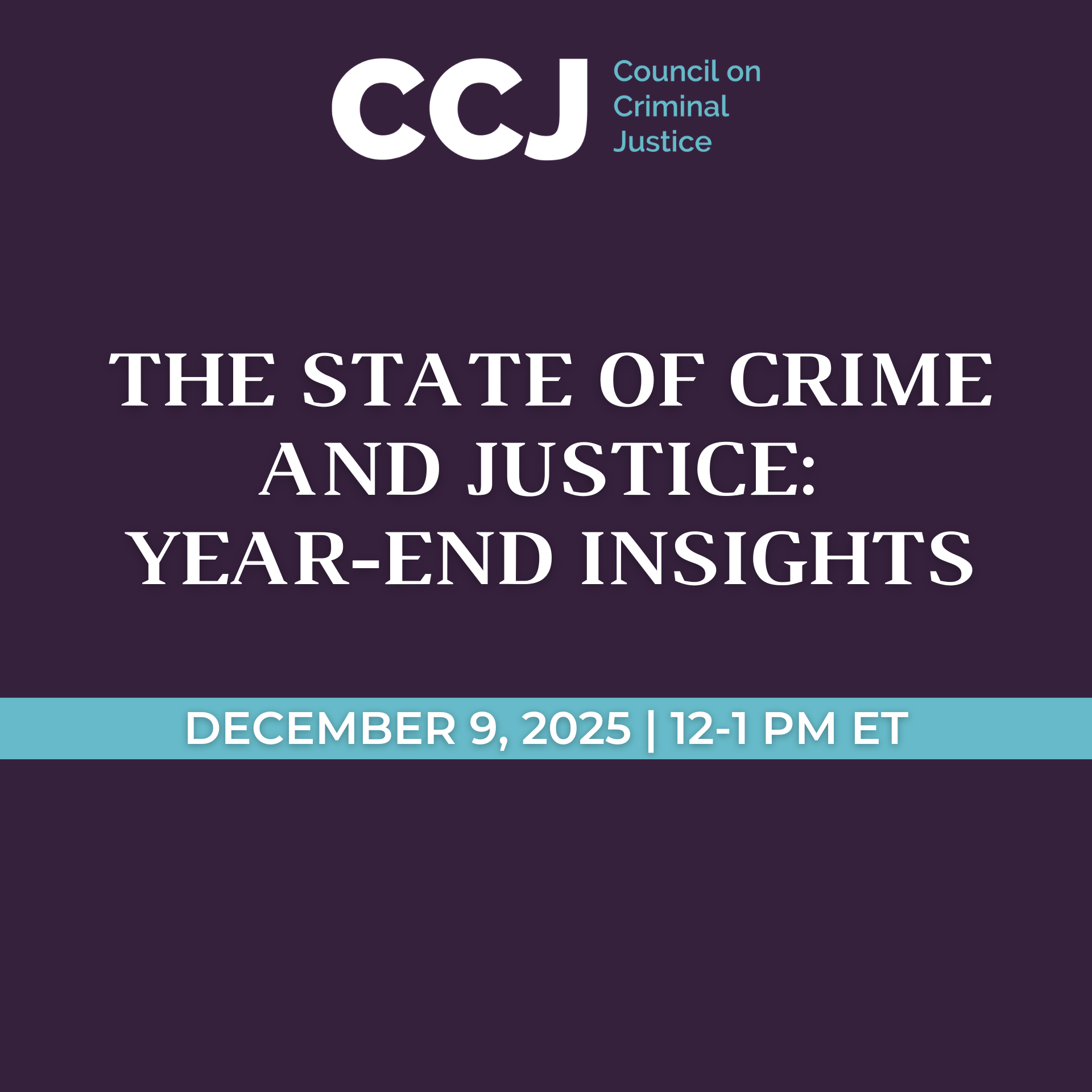New CCJ analysis shows domestic violence is only offense of 13 to increase in first half of 2025; motor vehicle theft only offense that remains higher than 2019 level
FOR IMMEDIATE RELEASE
5:00 a.m. ET, July 24, 2025
Contact: Brian Edsall
bedsall@counciloncj.org
845-521-9810
WASHINGTON — Homicide and other violent crimes continued to decline in the first half of this year, falling below levels seen before the onset of the COVID-19 pandemic and nationwide social justice protests of 2020, according to a new analysis of crime trends through June in 42 cities released today by the Council on Criminal Justice (CCJ).
The study examined patterns for 13 crime types in cities that have consistently published monthly data over the past six years, analyzing violent crime, property crime, and drug offenses. It found:
- Reported levels of 11 of 13 offenses were lower in the first six months of this year compared to the first half of 2024. Domestic violence was the only offense that rose during this period, while drug offenses remained even.
- Looking at trends over a longer period, only one offense—reported motor vehicle theft—remained elevated at mid-year 2025 compared to mid-year 2019 totals, while nonresidential burglaries were even with those levels.
Alongside the mid-year report, CCJ also released two analyses, one national, and one local, examining the share of violent crime that becomes lethal, finding that violence in America has become more deadly over time.
One Year Trends
The number of homicides in the 30 cities providing data for that crime was 17% lower when comparing the first half of 2025 to the same period in 2024, representing 327 fewer homicides in those cities. Twenty-five of the 30 study cities recorded a homicide decrease during the first half of the year, ranging from a drop of 45% in Denver, CO, to a 1% decline in Colorado Springs. Five cities experienced increases, ranging from 6% in Milwaukee, WI to 39% in Little Rock, AR.
Motor vehicle theft, a crime that had risen sharply from the summer of 2020 through 2023, reversed course in 2024 and continued to decline into the first six months of this year. There were 25% fewer motor vehicle thefts reported to law enforcement authorities in the first half of 2025 compared to the first half of 2024. Reported gun assaults (-21%), robberies (-20%), residential burglaries (-19%), non-residential burglaries (-18%), shoplifting (-12%), aggravated and sexual assaults (-10%), and larcenies (-5%) all fell in the first six months of 2025 compared to the first half of 2024. Drug offenses remained even during this time period, while domestic violence incidents increased 3%. Reports of carjackings, a type of robbery, also decreased by 24% during this period.
“These trends are promising, especially the drop in homicide rates, but much of the decrease in the national homicide rate continues to be driven by large declines in a handful of cities with high homicide levels,” said CCJ Senior Research Specialist Ernesto Lopez, co-author of the report. “More than half of the cities we studied continue to experience higher homicide levels compared to levels seen prior to the pandemic. While we should continue to invest in evidence-based crime reduction strategies, we must also be cautious about claiming what is currently reducing crime without more rigorous evidence.”
Trends Since 2019
Looking at trends in reported violent crime in the study cities over a longer period, the analysis found that there were 14% fewer homicides during the first half of 2025 compared to the same period in 2019, 30% fewer robberies, 28% fewer sexual assaults, 8% fewer domestic violence incidents, 5% fewer aggravated assaults, 4% fewer gun assaults, and 3% fewer carjacking incidents. Much of the decline in the national homicide rate, which began in late 2022, has been driven by large drops in a few sample cities with high homicide levels, such as Baltimore and St. Louis. The most recent data show that all of the sample cities are now below the general peak of 2020 to 2021, but more than 60% continue to experience homicide levels above pre-2020 rates.
Property crime trends have been more mixed over the last six years. There were 47% fewer burglaries, 27% fewer drug offenses, 19% fewer larcenies, and 4% fewer shoplifting incidents in the first half of 2025 compared to the same period in 2019. Of the 13 offenses covered in the analysis, only motor vehicle theft (+25%) remained elevated compared to mid-year 2019 levels, while nonresidential burglaries remained even with those levels.
Trends in Lethality
The Council today also released two analyses examining the share of violent crime that becomes lethal. One analysis examined long-term lethality trends and found that while overall violence has decreased in the United States, the share of violence that ends in death was about 3.6 times higher in 2020 than in 1994. Overall, there were 2.0 homicides per 1,000 assaults and 15.7 homicides per 1,000 robberies in 1994, and those ratios increased to 7.2 and 55.8, respectively, in 2020. Another analysis, looking at patterns in a sample of 17 large U.S. cities in more recent years, reached similar conclusions, finding that lethality increased sharply in 2020, and was 20% higher in 2024 than in 2018.
The report’s authors note that it is difficult to explain the national homicide decline with precision, but the increase in lethality, coupled with the declines in non-fatal violent crime, suggests that there are fewer situations in which people are at high risk of becoming the victim of a homicide, such as during a robbery.
“Understanding recent crime trends is not a purely academic exercise. Beyond the trauma and other direct consequences for victims and survivors, murder and other crimes come with immense societal costs,” said CCJ President and CEO Adam Gelb. “Even during periods of declining violence, efforts to reduce victimization and ensure public safety must remain a priority. We need a greater investment in research to better understand the changing crime landscape and craft effective crime control approaches for today and the future.”
The report’s authors noted that evidence-based crime reduction strategies, such as those prioritized by the Council’s Violent Crime Working Group, are still urgently needed. The authors called for policymakers and philanthropic organizations to use this period of declining street crime to improve our understanding and measurement of all crime, so the nation is better prepared to confront trends, or crises, in the future.
The authors also noted that compared to scholars of past decades, today’s researchers have access to significantly more—and more detailed—information on criminal incidents, along with a greater computing capacity to analyze data. Even with these improvements, however, crime data remain incomplete. The Council’s Crime Trends Working Group identified key gaps in criminal justice data, including information on non-fatal gun violence, white-collar crime, environmental crime, and cybercrimes, and produced a set of actionable recommendations for policymakers to close those gaps.
Support for the mid-year crime trends analysis comes from the Annie E. Casey Foundation, Arnold Ventures, the Harry Frank Guggenheim Foundation, Southern Company Foundation, and Stand Together Trust, as well the John D. and Catherine T. MacArthur Foundation and other CCJ general operating contributors.
About the Report and Data
Co-authored by Lopez and Bobby Boxerman, Ph.D., the new analysis updates and supplements previous U.S. crime trends reports by the Council on Criminal Justice with data through June 2025. It examines yearly and monthly rates of reported crime for 13 violent, property, and drug offenses in 42 American cities that have consistently reported monthly data over the past six years, including Atlanta, Baltimore, Boston, Chicago, Detroit, New York, Philadelphia, Seattle, and Washington, DC. The smallest city in the sample was Cary, NC, with about 182,000 residents; the largest was New York City, with about 8.3 million residents. The study cities are not necessarily representative of all jurisdictions in the U.S.; not all cities reported data for each offense; and figures reported here may differ from other sources and may by updated by the reporting jurisdictions.
About the Council on Criminal Justice
The Council on Criminal Justice is a nonpartisan think tank and invitational membership organization that advances understanding of the criminal justice policy challenges facing the nation and builds consensus for solutions that enhance safety and justice for all.



